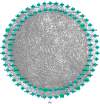Molecular Mechanisms of Cassia fistula against Epithelial Ovarian Cancer Using Network Pharmacology and Molecular Docking Approaches
- PMID: 36145718
- PMCID: PMC9500712
- DOI: 10.3390/pharmaceutics14091970
Molecular Mechanisms of Cassia fistula against Epithelial Ovarian Cancer Using Network Pharmacology and Molecular Docking Approaches
Abstract
Epithelial ovarian cancer (EOC) is one of the deadliest reproductive tract malignancies that form on the external tissue covering of an ovary. Cassia fistula is popular for its anti-inflammatory and anticarcinogenic properties in conventional medications. Nevertheless, its molecular mechanisms are still unclear. The current study evaluated the potential of C. fistula for the treatment of EOC using network pharmacology approach integrated with molecular docking. Eight active constituents of C. fistula were obtained from two independent databases and the literature, and their targets were retrieved from the SwissTargetPrediction. In total, 1077 EOC associated genes were retrieved from DisGeNET and GeneCardsSuite databases, and 800 potential targets of eight active constituents of C. fistula were mapped to the 1077 EOC targets and intersected targets from two databases. Ultimately, 98 potential targets were found from C. fistula for EOC. Finally, the protein-protein interaction network (PPI) topological interpretation revealed AKT1, CTNNB1, ESR1, and CASP3 as key targets. This is the first time four genes have been found against EOC from C. fistula. The major enriched pathways of these candidate genes were established by Gene Ontology (GO) and Kyoto Encyclopedia of Genes and Genomes (KEGG) investigations. To confirm the network pharmacology findings, the molecular docking approach demonstrated that active molecules have higher affinity for binding to putative targets for EOC suppression. More pharmacological and clinical research is required for the development of a drug to treat EOC.
Keywords: Cassia fistula; active constituents; anticarcinogenic; epithelial ovarian cancer; gene ontology; molecular docking; network pharmacology.
Conflict of interest statement
The funders had no role in the design of the study; in the collection, analyses, or interpretation of data; in the writing of the manuscript; or in the decision to publish the results.
Figures












Similar articles
-
Exploring active ingredients and mechanisms of Coptidis Rhizoma-ginger against colon cancer using network pharmacology and molecular docking.Technol Health Care. 2024;32(S1):523-542. doi: 10.3233/THC-248046. Technol Health Care. 2024. PMID: 38759074 Free PMC article.
-
Understanding apoptotic induction by Sargentodoxa cuneata-Patrinia villosa herb pair via PI3K/AKT/mTOR signalling in colorectal cancer cells using network pharmacology and cellular studies.J Ethnopharmacol. 2024 Jan 30;319(Pt 3):117342. doi: 10.1016/j.jep.2023.117342. Epub 2023 Oct 23. J Ethnopharmacol. 2024. PMID: 37879505
-
Exploring the pharmacological components and effective mechanism of Mori Folium against periodontitis using network pharmacology and molecular docking.Arch Oral Biol. 2022 Jul;139:105391. doi: 10.1016/j.archoralbio.2022.105391. Epub 2022 Mar 21. Arch Oral Biol. 2022. PMID: 35430443
-
Potential mechanism prediction of indole-3-propionic acid against diminished ovarian reserve via network pharmacology, molecular docking and experimental verification.BMC Complement Med Ther. 2024 Aug 27;24(1):316. doi: 10.1186/s12906-024-04611-1. BMC Complement Med Ther. 2024. PMID: 39192219 Free PMC article.
-
Exploration of the Effect and Potential Mechanism of Echinacoside Against Endometrial Cancer Based on Network Pharmacology and in vitro Experimental Verification.Drug Des Devel Ther. 2022 Jun 16;16:1847-1863. doi: 10.2147/DDDT.S361955. eCollection 2022. Drug Des Devel Ther. 2022. PMID: 35734366 Free PMC article.
Cited by
-
Analysis of the effects of acetyl tributyl citrate on bone cancer based on network toxicology and molecular docking.Front Med (Lausanne). 2025 Jun 23;12:1613657. doi: 10.3389/fmed.2025.1613657. eCollection 2025. Front Med (Lausanne). 2025. PMID: 40625361 Free PMC article.
-
Network pharmacology-based strategy to reveal the mechanism of pinocembrin against ovarian cancer.Naunyn Schmiedebergs Arch Pharmacol. 2025 Apr;398(4):3803-3815. doi: 10.1007/s00210-024-03492-y. Epub 2024 Oct 3. Naunyn Schmiedebergs Arch Pharmacol. 2025. PMID: 39361173
References
LinkOut - more resources
Full Text Sources
Research Materials
Miscellaneous

